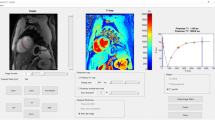Abstract
We propose a new method to improve T 1 mapping with respect to the popular DESPOT1 algorithm. A distance function is defined to model the distance between the pure signal and the measurements in presence of noise. We use a constrained gradient descent optimization algorithm to iteratively find the optimal values of T 1 and M 0. The method is applied to MR images acquired with 2 gradient echo sequences and different flip angles. The performance of T 1 mapping is evaluated both on phantom and on in vivo experiments.
Access this chapter
Tax calculation will be finalised at checkout
Purchases are for personal use only
Preview
Unable to display preview. Download preview PDF.
Similar content being viewed by others
References
Bagher-Ebadian, H., Jain, R., Paudyal, R., Nejad-Davarani, S.P., Narang, J., Jiang, Q., Mikkelsen, T., Ewing, J.R.: Magnetic resonance estimation of longitudinal relaxation time (T1) in spoiled gradient echo using an adaptive neural network. In: IJCNN, pp. 2557–2562 (2011)
Cao, F., Commowick, O., Bannier, E., Crimi, A., Barillot, C.: T1 and T2 mapping in patients with multiple sclerosis for project USPIO–6. In: ARSEP (June 2012)
Christensen, K.A., Grant, D.M., Schulman, E.M., Walling, C.: Optimal determination of relaxation times of fourier transform nuclear magnetic resonance. determination of spin-lattice relaxation times in chemically polarized species. J. Phys. Chem. 78(19), 1971–1977 (1974)
Dagia, C., Ditchfield, M.: 3t mri in paediatrics: challenges and clinical applications. Eur. J. Radiol. 68(2), 309–319 (2008)
Deichmann, R., Hahn, D., Haase, A.: Fast T1 mapping on a whole-body scanner. MRM 42(1), 206–209 (1999)
Deoni, S., Rutt, B., Peters, T.: Rapid combined T1 and T2 mapping using gradient recalled acquisition in the steady state. MRM 49(3), 515–526 (2003)
Deoni, S.C.L., Peters, T.M., Rutt, B.K.: Determination of optimal angles for variable nutation proton magnetic spin-lattice, T1, and spin-spin, T2, relaxation times measurement. MRM 51(1), 194–199 (2004)
Ferré, J.C., Tourbah, A., Berry, I., Barillot, C., Freeman, L., Galanaud, D., Maarouf, A., Pelletier, J., Portefaix, C., Ranjeva, J.P., Wiest-Daesslé, N., Edan, G.: MRI USPIO analysis in 35 clinically isolated syndrome patients. In: ECTRIMS 2011 vol. (5), pp. 399–416 (2011)
Gelman, N., Gorell, J., Barker, P., Savage, R., Spickler, E., Windham, J., Knight, R.: MR imaging of human brain at 3.0T: preliminary report on transverse relaxation rates and relation to estimated iron content. Radiology 210(3), 759–767 (1999)
Lee, C., Baker, E., Thomasson, D.: Normal Regional T1 and T2 Relaxation Times of the Brain at 3T, p. 959 (2006)
Ollivro, S., Eliat, P., Hitti, E., Tran, L., de Certaines, J., Saint-Jalmes, H.: Preliminary MRI quality assessment and device acceptance guidelines for a multicenter bioclinical study: The GO glioblastoma project. J. Neuroimaging (2011)
Stanisz, G., Odrobina, E., Pun, J., Escaravage, M., Graham, S., Bronskill, M., Henkelman, R.: T1, T2 relaxation and magnetization transfer in tissue at 3T. MRM 54(3), 507–512 (2005)
Tofts, P.: Quantitative MRI of the Brain: Measuring Changes Caused by Disease. John Wiley & Sons, Ltd. (2003)
Vaithianathar, L., Tench, C.R., Morgan, P.S., Constantinescu, C.S.: Magnetic resonance imaging of the cervical spinal cord in multiple sclerosis–a quantitative T1 relaxation time mapping approach. J. Neurology 250(3), 307–315 (2003)
Wang, H.Z., Riederer, S.J., Lee, J.N.: Optimizing the precision in T1 relaxation estimation using limited flip angles. MRM 5(5), 399–416 (1987)
Wang, J., Qiu, M., Kim, H., Constable, R.T.: T1 measurements incorporating flip angle calibration and correction in vivo. J. Magn. Reson. 182(2), 283–292 (2006)
Author information
Authors and Affiliations
Editor information
Editors and Affiliations
Rights and permissions
Copyright information
© 2012 Springer-Verlag Berlin Heidelberg
About this paper
Cite this paper
Cao, F., Commowick, O., Bannier, E., Ferré, JC., Edan, G., Barillot, C. (2012). MRI Estimation of T 1 Relaxation Time Using a Constrained Optimization Algorithm. In: Yap, PT., Liu, T., Shen, D., Westin, CF., Shen, L. (eds) Multimodal Brain Image Analysis. MBIA 2012. Lecture Notes in Computer Science, vol 7509. Springer, Berlin, Heidelberg. https://doi.org/10.1007/978-3-642-33530-3_18
Download citation
DOI: https://doi.org/10.1007/978-3-642-33530-3_18
Publisher Name: Springer, Berlin, Heidelberg
Print ISBN: 978-3-642-33529-7
Online ISBN: 978-3-642-33530-3
eBook Packages: Computer ScienceComputer Science (R0)




